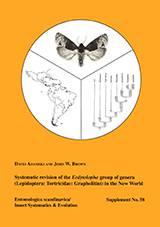Entomologica Scandinavica Supplement 58
now changed to Insect Systematics and Evolution Supplement
ESS 58.
Adamski, D. & Brown, J. W.: Systematic revision of the Ecdytolopha group of genera (Lepidoptera: Tortricidae: Grapholitini) in the New World. 2001. 86 pp. SEK 240.
Abstract:
The New World genera Ecdytolopha Zeller, Gymnandrosoma Dyar, revised status, and Pseudogalleria Ragonot are revised. As currently defined, Ecdytolopha includes 10 species: E. insiticiana Zeller, 1875 (type species), ranging from southern Canada to Florida, and from the East Coast to California; E. mana (Kearfott, 1907) from the southern United States (Arizona to Alabama, north to Maryland); E. exploramae, new species, from Peru; E. beckeri, new species, from Tamaulipas, Mexico; E. occidentana, new species, from Arizona, USA; E. coloradana, new species, from Colorado and New Mexico, USA; E. sinaloana, new species, from Sinaloa, Mexico; E. leonana, new species, from Nuevo Leon, Mexico; E. holodesma (Walsingham, 1914), new combination, from Morelos, Hidalgo, and Distrito Federal, Mexico; and E. ricana, new species, from Costa Rica. Gymnandrosoma includes 7 species: G. punctidiscanum Dyar, 1904 (type species), revised status, from the eastern and southeastern USA; G. cryptotortanum, new species, from Veracruz, Mexico; G. linaresensis, new species, from Nuevo Leon, Mexico; G. trachycerus Forbes, 1931, revised status, from the Caribbean; G. leucothorax, new species, from the Caribbean; G. aurantianum Costa Lima, 1927, revised status, from South America, Central America, and the Caribbean; and G. desotanum Heinrich, 1926, revised status, from Florida, USA. Pseudogalleria is monotypic, with the single species P. inimicella (Zeller, 1872), from eastern USA.
Members of these three genera include pests of Citrus, Robinia, Macadamia, Pithecellobium, Theobroma, and Psidium. We present a hypothesis of the phylogenetic relationships among these three New World genera and the Old World genera Cryptophlebia Walsingham and Thaumatotibia Zacher.

